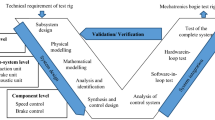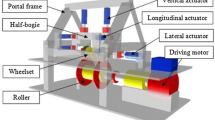Abstract
Proper values of the adhesion coefficient are the key to guarantee good operations of railway transportation systems in terms of safety, performances and punctuality during both braking and traction manoeuvres. Adhesion can drop to very low values due to contaminants lying on the track. However, the leading wheelsets have a cleaning effect on the rail, so that adhesion recovery can be observed on the following axles. A good knowledge of adhesion and adhesion recovery phenomenon is thus fundamental to optimize the dynamic behaviour of railway vehicles and to develop new algorithms for wheel slide protection (WSP) and antiskid systems. Several laboratory facilities are used to investigate adhesion, due to the high costs of on-track tests with full vehicles. Anyway, these devices do not allow a good simulation of the vehicle dynamics and of the real contact conditions. To overcome these issues, roller rigs usually represent a good compromise in terms of costs, safety, repeatability of the tests and simulation of the real contact conditions and vehicle dynamics. However, typical roller rigs consist of one or more wheelsets rolling over separate pair of rollers. An evolution of roller rigs, consisting of multiple wheelsets acting on the same contaminated surfaces, is thus needed to study the adhesion recovery phenomenon more properly. The paper concerns the experimental setup of an innovative 1:5 scaled multi-axle roller rig developed at Politecnico di Torino. The rig is intended to allow researchers to obtain a deep understanding of the mutual interaction of different following wheelsets running on a contaminated track.













Similar content being viewed by others
Abbreviations
- f :
-
Adhesion coefficient
- F b :
-
Braking force
- F s :
-
Suspension load
- F x :
-
Tangential load at the wheel-roller interface
- g :
-
Gravity acceleration
- I R,yy :
-
Polar inertia of the rollers
- I w,yy :
-
Polar inertia of the wheelset
- m :
-
Mass of the wheelset
- N :
-
Normal load at the wheel/roller interface
- p F\B :
-
F\b pressure at the outlet of the valves
- p SET :
-
Set pressure at the outlet of the valves
- R PAD :
-
Braking effective radius
- R R :
-
Roller radius
- R w :
-
Wheel radius
- T M :
-
Torque produced by the motor
- T R,0 :
-
Initial resistant torque
- T R,b :
-
Resistant torque due to braking effort
- V IN :
-
Set voltage
- V OUT :
-
FeedBack voltage
- α :
-
Angle of inclination of the wheelse
- ξ :
-
Creep
- τ :
-
Transmission ratio (ration between roller and wheel radius)
- ω R :
-
Angular speed of the rollers
- ω w :
-
Angular speed of the wheels
- \( {\dot{\omega}}_R \) :
-
Angular acceleration of the rollers
- \( {\dot{\omega}}_w \) :
-
Angular acceleration of the wheelset
- b :
-
Braking
- i :
-
Wheelset number (i = 1 ÷ 4)
- j :
-
Wheel number (j = 1,2)
- R :
-
Roller
- s :
-
Suspension
- w :
-
Wheelset
References
Harrison H, McCanney T, Cotter J (2002) Recent developments in coefficient of friction measurements at the rail/wheel interface. Wear 2002 253:114–123
Lewis R, Lewis SR, Zhu Y, Abbasi S, Olofsson U (2013) The modification of a slip resistance meter for measurement of railhead adhesion. P I Mech Eng F-J Rai 227(2):196–200
Olofsson U, Sundvall K (2004) Influence of leaf, humidity and applied lubrication on friction in the wheel-rail contact: pin-on-disc experiments. P I Mech Eng F-J Rai 218(3):235–242
Stolarski TA (1989) Friction in a pin-on-disc configuration. Mech Mach Theory 24(5):373–381
Zhu Y, Olofsson U, Persson K (2012) Investigation of factors influencing wheel-rail adhesion using a mini-traction machine. Wear 292-293:218–231
Galas R, Omasta M, Krupka I, Hartl M (2016) Laboratory investigation of ability of oil-based friction modifiers to control adhesion at wheel-rail Interface. Wear 368-369:230–238
Chen H, Ban T, Ishida M, Nakahara T (2008) Experimental investigation of influential factors on adhesion between wheel and rail under wet conditions. Wear 265(9–10):1504–1511
Wang WJ, Liu TF, Wang HY, Liu QY, Zhu MH, Jin XS (2014) Influence of friction modifiers on improving adhesion and surface damage of wheel/rail under low adhesion conditions. Tribol Int 75:16–23
Lewis SR, Lewis R, Cotter J, Lu X, Eadie DT (2016) A new method for the assessment of traction enhancers and the generation of organic layers in a twin-disc machine. Wear 366-367:258–267
Gallardo-Hernandez EA, Lewis R (2008) Twin disc assessment of wheel/rail adhesion. Wear 265(9–10):1309–1316
Fletcher DI, Lewis S (2013) Creep curve measurement to support Wear and adhesion modelling, using a continuously variable creep twin disc machine. Wear 298-299(1):57–65
Meymand, S, Hosseinipour, M., Ahmadian M. 2015. "The Development of a Roller Rig for Experimental Evaluation of Contact Mechanics for Railway Vehicles. ASME. ASME/IEEE Joint Rail Conference, 2015 Joint Rail Conference
Bosso N, Zampieri N (2014) Experimental and numerical simulation of wheel-rail adhesion and Wear using a scaled roller rig and a real-time contact code. Shock Vib 2014
Bosso N, Zampieri N (2013) Real-time implementation of a traction control algorithm on a scaled roller rig. Veh Syst Dyn 51(4):517–541
Bosso, N., A. Gugliotta, and N. Zampieri. 2014. "Study of adhesion and evaluation of the friction forces using a scaled roller-rig, 5th World Tribology Congress, WTC 2013, Volume 3, 2014, Pages 2640-2643
Bosso N, Zampieri N (2018) A novel analytical method to calculate wheel-rail tangential forces and validation on a scaled roller-rig. Advances in Tribology 2018. https://doi.org/10.1155/2018/7298236
Zhang W, Chen J, Wu X, Jin X (2002) Wheel/rail adhesion and analysis by using full scale roller rig. Wear 253(1–2):82–88
Jaschinski A, Chollet H, Iwnicki S, Wickens A, Von Würzen J (1999) The application of roller rigs to railway vehicle dynamics. Veh Syst Dyn 31(5–6):345–392
Ahn, K., J. Park, and S. Ryew. 2012. "The Construction of a Full-Scale wheel/rail Roller Rig in Korea
Myamlin, S., J. Kalivoda, and L. Neduzha. 2017. "Testing of Railway Vehicles using Roller Rigs
Chollet, H. 1998. "Essais en similitude a l’echelle 1r4 de bogies de wagons de la famille Y25
Iwnicki, S.D. and Shen, Z.Y. 1992. "Collaborative railway roller rig project
Jaschinski, A. 1990. "On the application of similarity Laws to a scaled railway bogie model
Liu B, Bruni S (2015) Analysis of wheel-roller contact and comparison with the wheel-rail case. Urban Rail Transit 1(4):215–226
Keylin, A., M. Ahmadian, M. Taheri, and A. Tajaddini. 2012. "Wheel-Rail Contact Characteristics on a Tangent Track Vs a Roller Rig
Nakazawa S-I, Hijikata D (2017) Wheel slide protection system by the use of the tangential force in the macro slip area. Quarterly Report of RTRI (Railway Technical Research Institute) 58(3):196–203
Barna, G. 2012. "Diagnosis of Wheel Slide Protection Systems for Rail Vehicles
Stützle, T., U. Viereck, A. Stribersky, W. Rulka, M. Enning, and D. Abel. 2006. "Creepage Control for use in Wheelslide Protection Systems
Kondo, K. 2012. "Anti-Slip Control Technologies for the Railway Vehicle Traction
Pichlík , P. Zděnek, j. (2014) Overview of slip control methods used in locomotives. Transactions on Electrical Engineering 3(2)
Lewis, S. R., R. Lewis, G. Evans, and L. E. Buckley-Johnstone. 2012. "Assessment of railway grease performance using a twin-disc tester
Omasta M, Machatka M, Smejkal D, Hartl M, Křupka I (2015) Influence of sanding parameters on adhesion recovery in contaminated wheel-rail contact. Wear 322-323:218–225
Arias-Cuevas O, Li Z, Lewis R, Gallardo-Hernández EA (2010) Rolling-sliding laboratory tests of friction modifiers in dry and wet wheel-rail contacts. Wear 268(3–4):543–551
Arias-Cuevas O, Li Z, Lewis R (2011) A laboratory investigation on the influence of the particle size and slip during sanding on the adhesion and Wear in the wheel-rail contact. Wear 271(1–2):14–24
Li Z, Arias-Cuevas O, Lewis R, Gallardo-Hernández EA (2009) Rolling-sliding laboratory tests of friction modifiers in leaf contaminated wheel-rail contacts. Tribol Lett 33(2):97–109
Voltr P, Lata M (2015) Transient wheel-rail adhesion characteristics under the cleaning effect of sliding. Veh Syst Dyn 53(5):605–618
Allotta, B., R. Conti, E. Meli, L. Pugi, and A. Ridolfi. 2014. "Development of a Full-Scale Roller-Rig to Test High Speed Trains Under Degraded Adhesion Conditions
Allotta, B., R. Conti, E. Meli, L. Pugi, and A. Ridolfi. 2014. "Study of high-speed train dynamics under degraded adhesion conditions: an innovative HIL architecture for full-scale roller-rigs
Bosso N, Gugliotta A, Zampieri N (2015) Strategies to simulate wheel-rail adhesion in degraded conditions using a roller-rig. Veh Syst Dyn 53(5):619–634
Bosso N, Gugliotta A, Zampieri N (2016) A test rig for multi-wheelset adhesion experiments, vol 110. Civil-Comp Proceedings
CEN-European Committee for Standardization: EN 15806, railway applications – braking – static brake testing. 2010
Author information
Authors and Affiliations
Corresponding author
Ethics declarations
Conflict of Interest
On behalf of all authors, the corresponding author states that there is no conflict of interest.
Additional information
Publisher’s Note
Springer Nature remains neutral with regard to jurisdictional claims in published maps and institutional affiliations.
Rights and permissions
About this article
Cite this article
Bosso, N., Gugliotta, A., Magelli, M. et al. Experimental Setup of an Innovative Multi-Axle Roller Rig for the Investigation of the Adhesion Recovery Phenomenon. Exp Tech 43, 695–706 (2019). https://doi.org/10.1007/s40799-019-00327-x
Received:
Accepted:
Published:
Issue Date:
DOI: https://doi.org/10.1007/s40799-019-00327-x




